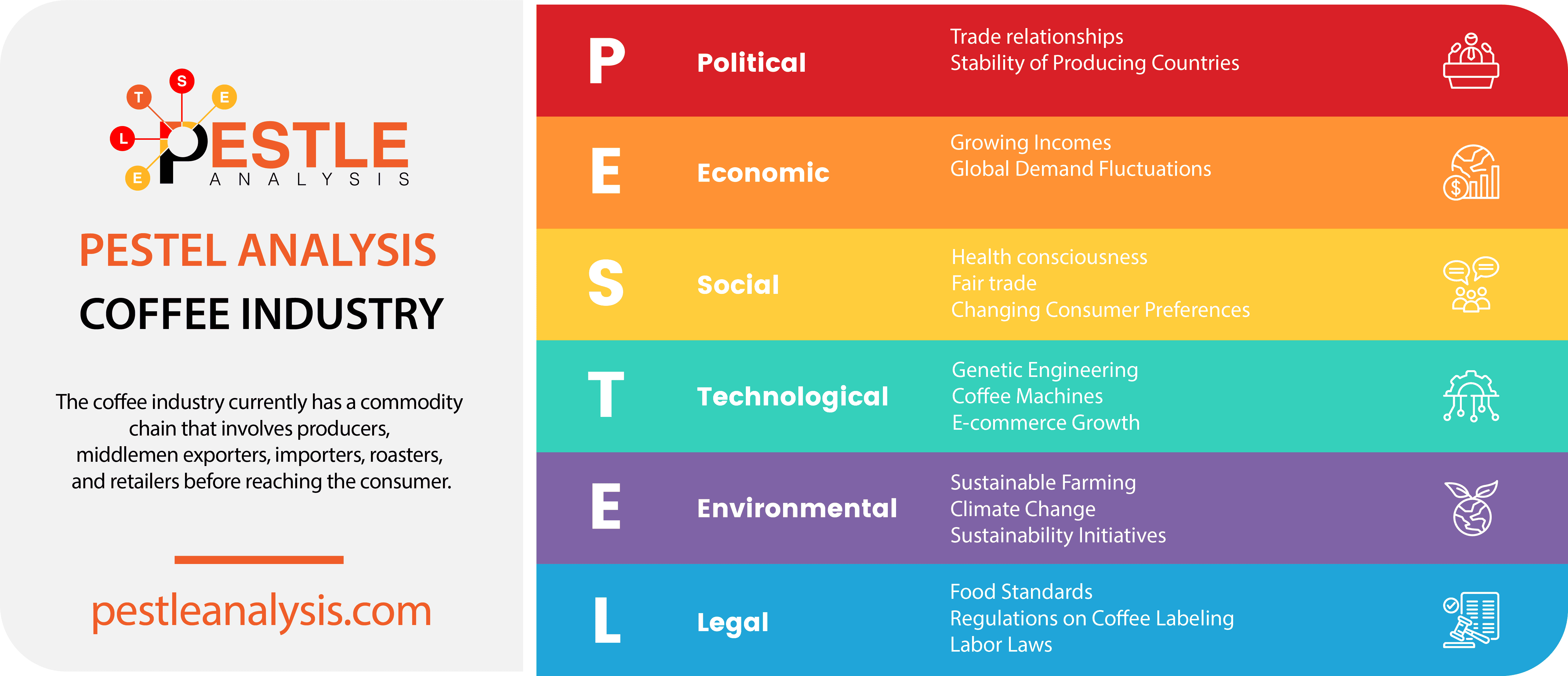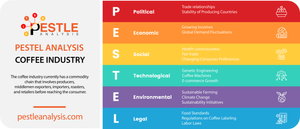What PESTEL analysis can tell us is that the overall business environment has both pluses and minuses for the coffee industry.
In this article, we'll use PESTEL analysis to evaluate the macro environment of the coffee industry. That means looking at the Political, Economic, Sociocultural, Technological, Environmental, and Legal factors affecting this industry to see how it might progress over the coming years. Coffee is a hot beverage that we as humans have been drinking for more than 500 years. Known and loved the world over, this drink represents an industry worth over $100 billion. With coffee being a mainstay of many individuals' day-to-day life, it's hard to imagine a future where the coffee industry doesn't thrive.
What is PESTLE Analysis?
PESTLE analysis is a strategic planning tool used by business and project managers. It examines the Political, Economic, Sociocultural, Technological, Legal, and Environmental factors that affect a company or an entire industry.
Coffee Industry PESTLE Analysis
Political factors affecting the Coffee industry
Here is a Political factor affecting the coffee industry:
- Trade relationships: The business of coffee and running a coffee shop is highly dependent on international trade. The world's biggest coffee producers are located in Asia, South America, and Africa, and yet, the drink is especially popular in Europe and North America. Trade relationships between countries that produce and consume coffee play a big role in determining the final price tag of the beverage, which ultimately impacts sales. Currently, there are a number of international trade agreements ensuring the success of the coffee industry. Uncertain trade circumstances (such as those involving the US and China or the UK and Europe) are unlikely to affect the coffee industry.
Economic factors affecting the Coffee industry
Here is an Economic factor affecting the coffee industry:
- Growing incomes: As the world's many economies continue to grow, there's one common benefit: consumers have growing incomes. This means consumers have more money to spend every year. While this can hugely impact consumer goods industries (such as the consumer electronics industry), it also impacts food and drink industries. As consumers get richer, they are more likely to consume tea, coffee, and other such luxury beverages. Also, with growing incomes, consumers are more likely to splurge on higher quality produce, such as higher quality coffee grounds.
Social factors affecting the Coffee industry
Here are two Sociocultural factors affecting the coffee industry:
- Health consciousness: The 21st century has seen a lot of change in society's view of health. Making healthy choices is trendier than ever, and this is causing consumers to spend more time exercising, eat better food, and avoid certain habits. While numerous studies have confirmed that coffee is not "unhealthy", it does contain large amounts of caffeine. As part of the health consciousness trend, many consumers are choosing to give up caffeinated beverages for improved mood, sleep, and more. This may result in a reduced demand for coffee (and equally, a greater demand for decaffeinated coffee products).
- Fair trade: Another prominent sociocultural trend is fair trade. Fair trade is an international movement that seeks to better compensate the farmers behind produce, instead of the many middlemen that have historically reaped huge profits. Importantly, the coffee industry is one of the main targets for the fair trade movement. As consumers show greater demand for fair trade coffee products, farmers will earn more and middlemen will earn less. However, fair trade should not affect the overall size of the industry, unless fair trade coffee prices (which are higher than regular coffee prices) drive away consumers.
Technological Factors Affecting the Coffee industry
Here are two Technological factors affecting the coffee industry:
- Genetic engineering: One of the most important technological trends across all food and drink industries is that of genetic engineering. Genetic engineering involves modifying produce at the genetic level to improve yield, taste, shelf-life, and more. Genetically engineered coffee (which carries the "GMO" label) is quickly growing in popularity within the industry. On the whole, genetic engineering should help to grow the coffee industry, as it allows producers to generate larger profits. However, some consumers prefer not to consume genetically engineered products due to a number of purported side effects.
- Coffee machines: Another big change in the coffee industry is the advent of new, coffee-specific appliances. Coffee grinders, drip machines, and espresso makers are now available at every electronics store. These appliances make it easier than ever to consume coffee, thereby encouraging consumers to take up brewing at home. This shouldn't affect the overall size of the coffee industry, but may result in more consumers making and drinking coffee at home, with fewer consumers drinking coffee outside of the house in coffee shops.
Environmental factors affecting the Coffee industry
Here is an Environmental factor affecting the coffee industry:
- Sustainable farming: The world is facing numerous environmental issues. While some of these issues are unrelated to the food and drink industries — like automotive CO2 emissions — some of them are. In particular, unsustainable farming processes can result in deforestation. There are other concerns related to farming, such as the use of pesticides and fertilizers or water consumption. In any case, the world is pushing for more sustainable farming practices. Ultimately, this is likely to result in an increased cost for the consumer, which may harm the coffee industry.
Legal factors affecting the Coffee industry
Here is a Legal factor affecting the coffee industry:
- Food standards: As a product designed for consumption, coffee falls under food and drink regulations in nearly all of the world's jurisdictions. This means it's subject to a wide range of laws on how it should be stored, transported, and brewed. Further to this, coffee contains large amounts of caffeine, so it's subject to caffeine standards in some parts of the world. These standards are only becoming tighter with time, but safe coffee handling is so easy to get right that it shouldn't be a problem for the industry.

Recommendations: Taking action based on the PESTEL Analysis of the Coffee Industry
By this point, the coffee industry is well-established. From farm to cup, there are hundreds of cogs working together to power this multi-billion dollar industry. What PESTEL analysis can tell us is that the overall business environment has both pluses and minuses for the coffee industry.
On the plus side, the world currently has plenty of trade agreements, consumers' incomes are growing, and coffee appliances are more available than ever. The issue of genetically engineered coffee has both positives and negatives, allowing the industry to reap greater profits, but also scaring off some consumers. The fair trade movement and sustainable farming also have mixed consequences, ensuring benefits for the planet (and farmers) but higher costs for consumers. The main coffee-related downside in the current business environment is, without a doubt, growing caffeine consciousness.
For further reading, check out the following analysis of the coffee industry's leaders (or the industry's analysis here):
- PESTLE Analysis of Starbucks
- PESTLE Analysis of Dunkin'
- PESTLE Analysis of Nestle
- PESTLE Analysis of Costa Coffee
And that's not all. Check out many more PESTLE analysis examples and find everything you need to know about PESTLE analysis here!


